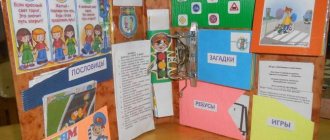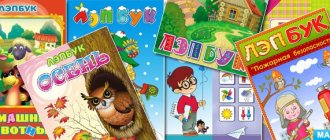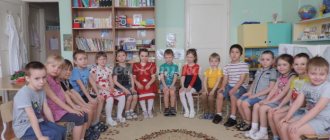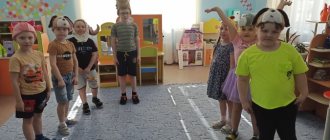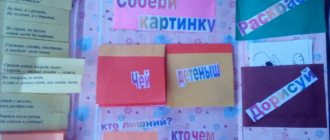Do-it-yourself lapbook “Pets” for preschoolers
Didactic manual lapbook “Pets” for kindergarten
Author: Yulia Valerievna Torop, preschool teacher at MBDOU “Kindergarten No. 132” in the city of Dzerzhinsk, Nizhny Novgorod region. Description: The manual is intended for preschool children. Objectives: 1. Systematize children’s knowledge on the topic; 2. Know and classify wild and domestic animals; 3. Develop observation and attentiveness. With the introduction of the Federal State Educational Standard, every preschool teacher is in constant search for new forms of organizing educational activities. A laptop is a wonderful find for a teacher. This type of benefit appeared relatively recently in our country, but its popularity is only growing. Literally translated, the term “lapbook” is “a book on your lap.” That is, it is a thematic folder with many pockets and windows, which contains material on a specific topic. It is recommended to do this benefit together with children and parents. The value of such a folder for each child increases. And parents have the opportunity to spend even more time with their child. I present to your attention a lapbook on the topic “Pets”. A little about production and materials. The basis for creating such a folder was an ordinary ceiling tile. I needed 2 of them: one was whole, and I cut the second in half, imitating an opening book. I fastened the parts together with regular wide tape. Well, in order for the product to have an aesthetic appearance, the tape was decorated with strips of foam rubber. I pasted the name of my folder on the front side. Well, now about the filling. I found some on the Internet, and did some myself. On the left side of the book I have a pocket with poems about animals . It is made in the form of a book with pictures. You can not only read poetry, but also look at the animal.
Pocket “Who Lives Where?” consists of two sheets, in the center of one is a village house, in the center of the other is a forest. Around each picture there are 7 empty windows. In another pocket there are wild and domestic animals. There may be several game options. 1. Cards with animals are laid out on the table. You can ask your child which animals live in the forest and which ones live next to humans. 2. Cards with animals are laid out, for example, around the forest. One animal is domestic. Ask your child the question: “Name the animals. Do all animals live in the forest? What animal is not wild? Etc.
There are several pockets in the center. On the largest sheet are riddles about animals. The child’s task is to guess the riddle and find a picture of an animal. One more sheet - tell us about the animal. If a child can’t read, it doesn’t matter. Using diagrams and symbols, children can quite independently describe any animal. At first it will be a set of proposals. And then, over time, this set of sentences will turn into a monologue - a description.
The “Collect a picture” pocket is made on the principle of a puzzle. From the parts you need to assemble a picture of an animal.
“Name the baby” pocket. The purpose of this pocket is speech development. Game options. 1. Invite your child to name a pet (of your choice). And then find and name one cub, two cubs. (pig - piglet - piglets). 2. All the same piglets lost their mother. Find her, as the mother of piglets is called.
The “Find the Shadow” pocket invites the child to find a color picture of an animal and its shadow.
“Pick up the fur.” Here we are “working out” the appearance of the animal. I left only the outline of the animal, but I need to pick up a picture with the animal’s fur and put it below. This is how the animal “gets dressed.” On the left side of the book there is a “Coloring Book” pocket. It can be constantly replenished. Children choose the picture they like and color it. Well, the final “pocket” is “Favorite Food”. It is a circle divided into sectors, which depicts the food of animals, not just domestic ones. And there are animals attached to clothespins. The child’s task is to match the animal and its favorite food.
A lapbook on the topic “Wild Animals” was made using the same principle.
I hope my material will be useful to you. Good luck!
We recommend watching:
Lapbook for kindergarten: Trees on our site: Cherry Lapbook for kindergarten: Properties of water Lapbook on fire safety in kindergarten. Senior - preparatory group Do-it-yourself laptop for kindergarten on the theme: Autumn. Junior group. Guidelines for
Similar articles:
Games and tasks for children 5-7 years old on the topic “Cow”
DIY didactic game for preschoolers
Summary of a game lesson in the younger group
Lapbooks on the topic “Pets, birds and pets”
Contained in sections:
- Pets. All materials 3835
- Poultry. Poultry yard 906
- Lapbook. Lapbooks on all topics 7255
Showing publications 1-10 of 116. All sections | Pets and birds. Lapbook
New
Photo
The best
Lapbook “Pets”
From early childhood it is important to introduce children to pets . Talk about their characteristics and care, cultivate a love for pets and a desire to care for them. Understand that animals are an integral part of wildlife . Not all parents have the opportunity to...
Lapbook “Who eats what” in the first junior group “Domestic and wild animals”
Lapbook “Who eats what”
made to consolidate the material covered on cognitive development (familiarization with the environment.
The lapbook can also be used as a didactic game during individual lessons with children. The task of such a lapbook is to consolidate and…
Pets and birds. Lapbook – Lapbook “Wild and Domestic Animals”
Publication “Lapbook “Wild and Domestic...”
Lapbook “Wild and Domestic Animals” This lapbook is made for preschoolers of all age categories and is aimed at developing the cognitive processes of preschoolers. Working with a lapbook meets the main thesis of organizing partnership activities between an adult and children. -involvement...
Image library "MAAM-pictures"
Lapbook “Pets”
Lapbook “Pets” A lapbook (interactive folder) is a homemade cardboard folder with pockets, windows, and movable parts that can be taken out, folded and rearranged at your discretion. A laptop is made together with children on a specific topic. He…
Lapbook “Pets” in the second junior group
Lapbook "Pets". Didactic material that helps enrich children's knowledge about domestic animals. Helps you learn new material and reinforce what you have learned in a playful way. At any time, the child simply opens the laptop and happily repeats with the help of an adult...
Lapbook “Pets”
Goal: to arouse interest in the topic being studied, increase curiosity, attract children to individual and joint activities under the guidance of an adult. Tasks: - clarify the names of domestic animals and their cubs; - develop fine motor skills; - develop memory and auditory...
Lapbook “Farm Frenzy”
Lapbook “Farm Frenzy”
for preschool children
performed by Alexandra Gennadievna Galkina, senior teacher
kindergarten No. 122 of JSC Russian Railways, Yekaterinburg
Goal: generalization and systematization of children’s knowledge on the topic of pets.
Tasks:
1.
Study materials about laptops; 2. Creating diagrams, pockets, choosing a theme, materials;
3.Learn to practically apply in teaching activities Relevance
This topic is that a lapbook is an excellent way to consolidate and repeat materials from a project or thematic week on the topic “Pets.” The lapbook is variable, since there are several options for using each of its parts. Promotes individualization of the educational process in the preschool age group
Lapbook contents
1. Poems about pets
2. Table and finger theater “Domestic Animals Dispute”
3. Mnemonic table for compiling a descriptive story on the topic “PETS”
4. Montessori game “Family. Pets"
This game introduces children to the concept of “family” in the world of pets and helps expand vocabulary, teaches the child classification techniques, as well as reading skills.
The family of each pet is given four cards: three with individual images of family members and one generalizing large card. Each card contains the name of family members, and the general card contains the name of the family as a whole.
There can be many games with cards.
Game "Family". Tell your child that animals, like people, live in families. There is a family of cows, sheep, etc. Cut the large Males, Females, Cubs cards into small cards. By placing small cards with family members on large cards, call them “This is daddy bull, mommy cow, baby calf.” Over time, the baby will be able to lay out the cards himself.
Game "Loto". Use three large cards "Male", "Female", "Cub" and cut small cards to play lotto.
Game "Animal History". Using cards with members of the same family, invite your child to tell a story. For example, “Papa bull went to the water, momma cow chewed grass, and baby calf ran on the lawn.”
5. Lacing “Farm Animals”
Goal: Development of fine motor skills of the hands.
6. Whose tail is farm animals
Game "Whose
tail - these are tasks with clothespins “Whose tail is farm animals”. Tasks for children from 1.5 to 6 years old. The set includes: horse, cow, sheep, goat, pig and rabbit. The tail of each animal is unique and children will find it easy and interesting to attach them.
7. Poems about pets. Cards and mini-book.
8. Mini set “Pets”
1) cards with images and names of animals; 2) a mini-book that children will happily glue together; 3) game “Memory”; 4) application.
9. Farm animals – put the halves and puzzles together
“Fold the halves” and “Puzzles” tasks
. Tasks for children from 1.5 to 6 years old. Each age has its own version of tasks. For older children, you can mix all the parts and ask them to fold each animal, but for kids it is better to immediately prepare the correct halves. For them, the process of connecting is already a difficult task that they will have to cope with. Focus on your children's abilities and help them grow in them.
10.Who says what?
11. Who does what?
MAGAZINE Preschooler.RF
Methodological manual for children of the second younger group. Lapbook "Pets".Completed by: Kharavinkina I.I. MBDOU "Atamanovsky kindergarten" of a combined type. 2019-2020
With the introduction of the Federal State Educational Standard, every preschool teacher is in constant search for new forms of organizing educational activities. A laptop is a wonderful find for a teacher. This type of benefit appeared relatively recently in our country, but its popularity is only growing.
Literally translated, the term “lapbook” is “a book on your lap . That is, it is a thematic folder with many pockets and windows in which material on a specific topic is collected. It is recommended to do this benefit together with children and parents. The value of such a folder for each child increases.
And parents have the opportunity to spend even more time with their child.
Problem:
A significant decrease in the cognitive activity of children; the need for independent knowledge of the surrounding reality is not sufficiently formed.
I present to your attention a lapbook on the topic “Pets” .
Goal: to arouse interest in the topic being studied, increase curiosity, attract children to individual and joint activities under the guidance of an adult.
Tasks:
- Educational: expand and consolidate children’s knowledge about domestic animals and their cubs (what they eat, where they live, what benefits they bring, distinguish by external features and structure);
- Developmental: develop gross motor skills, coordination, visual memory; develop coherent speech; develop children's verbal and logical thinking;
- Educational: cultivate a love for pets.
Age: For children 3-4 years old.
A laptop for preschoolers is an amazing and very useful guide that has gained popularity in our country relatively recently. This manual helps you quickly and effectively learn new information and consolidate what you have learned in an entertaining and playful way. The laptop is multifunctional; it consists of several games that serve a specific purpose. It’s especially nice to make a lapbook with your own hands.
A laptop can be used in educational activities, as well as during routine moments, for joint and individual activities. It is a thematic interactive folder with various pockets and curly envelopes.
The design of the lapbook includes: a rotating circle, pockets, cut and whole plot pictures, and flat images of animals.
Lapbook includes:
1. Pocket “Labyrinth”
Goal: development of fine differentiated movements of the fingers, visual-spatial orientation on a sheet of paper.
2. Pocket “Think whose footprints these are”
Goal: To be able to distinguish traces of domestic animals, to develop observation, attention, logical thinking, and speech in children.
3. Cut-out pictures: “Puzzles”
Goal: To teach the perception of a holistic image; develop attention and perseverance.
4. Pocket: “Complete the animal .
Goal: development of visual perception, attention, logical thinking.
5. D/i. circle: “Who eats what?”
Goal: consolidate knowledge on the topic, create conditions for activating the child’s vocabulary on this topic, develop the ability to analyze, consolidate the ability to distinguish and name animals, and develop fine motor skills.
6. D/i. "Tell me about your pet"
Goal: to form in children an idea of a holistic image, to teach children to compose descriptive stories about pets, using a plan.
7. Pocket: “Whose baby?”
Goal: to consolidate children's knowledge of naming domestic animals and their babies.
8. D/i “Find the shadow”
Goal: development of children's visual perception, attention, logical thinking.
9. Pocket: “What benefits do they bring?”
Goal: To enrich the vocabulary on the topic, to introduce words into the children’s dictionary that will be new to them.
10. Pocket: “Find a family”
Goal: to consolidate children’s ideas about domestic animals and their cubs, as well as to form the concept of “Family”.
This lapbook is a great way to review and consolidate the material you have covered. At any convenient time, the child simply opens the laptop and happily repeats what he has learned, looking at the pictures and completing tasks.
As a result, children will know the names of domestic animals and their babies; they learn that a person cares for domestic animals (feeds, waters, treats, washes, protects, grazes); They will also know what pets eat and what benefits pets bring to people; children will use the names of domestic animals and their cubs in speech, and will love and care for their pets.
| Next > |
Lapbook for working with young children “Pets”
Alla Stalchuk
Lapbook for working with young children “Pets”
This lapbook is intended for working with young children (2-3 years old).
Goal: to introduce and examine domestic animals with children, name them, paying attention to their characteristic features: “the cow is big, it has horns, hooves, a long tail with a tassel,” etc.; reinforce with children the signs of differences and similarities between domestic animals: “a cat and a dog have a mustache, but no hooves or horns.”
Objectives: clarify the names of animals and their cubs; develop the eye and visual attention; fine motor skills training; development of memory and auditory attention; consolidation of coherent speech; clarify the names of body parts; development of logical thinking.
A laptop can be used in educational activities, as well as during routine moments, for joint and individual activities. It is a thematic interactive folder with various pockets and envelopes. The laptop has pockets of a convenient shape, small size, durable, and convenient for use by children. The child can open the pockets independently without much effort.
All cards and pictures are laminated, which will allow you to use the laptop for a long time. The laptop consists of four parts.
List of tasks presented in the laptop:
The first block (the most voluminous):
1. Pictures of “pets”.
Goal: teach children to name pets.
2. Poems on the lexical topic “Pets”.
Goal: to develop general speech skills, work on intonation expressiveness of speech, and develop children’s memory.
3. Didactic game “Halves Pictures”.
Goal: to develop in children the ability to compose a whole image from two parts.
4. Didactic game “Mom and Cub”.
Goal: to teach children to distinguish between adult animals and their babies; develop the child’s thinking, speech, and vocabulary.
Second block (left side):
1. Didactic game “Who says what.”
Goal: to develop children's cognitive interest, auditory perception and thinking in children.
2. Didactic game “Me and my shadow.”
Goal: development of children's visual perception, attention, logical thinking.
Third block (right side):
1. Riddles about pets.
Goal: to develop oral speech in children and enrich their vocabulary.
